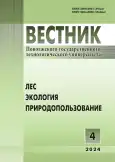Forecasting the Radiation Situation and External Exposure of Forestry Workers at a Soil Pollution Density of 137Cs 37-185 kBq/m2
- Authors: Perevolotsky A.N.1, Perevolotskaya T.V.1
-
Affiliations:
- Russian Institute of Radiology and Agroecology of National Research Centre “Kurchatov Institute”
- Issue: No 4 (64) (2024)
- Pages: 74-82
- Section: Проблемы экологии и рационального природопользования. Биотехнологии
- URL: https://journal-vniispk.ru/2306-2827/article/view/284655
- DOI: https://doi.org/10.25686/2306-2827.2024.4.74
- EDN: https://elibrary.ru/LUOTXU
- ID: 284655
Cite item
Full Text
Abstract
Introduction. Thirty-five years after the Chernobyl accident, approximately 662 thousand hectares of forest plantations in the Russian Federation are growing in the areas affected by radioactive contamination, which requires ensuring radiation safety in forestry operations. The purpose of the study is to predict the radiation situation and external radiation doses to workers in forest plantations where the 137Cs contamination density of soil varies within the range of 37–185 kBq/m2. Objects and methods. The object of the study is a conditional district forestry that has an area of 10,000 hectares and includes 100 forest compartments. The density of soil pollution with 137Cs was modeled in the range from 50 to 180 kBq/m2. For the 2024 to 2084 period, forecast calculations of the density of soil pollution with 137Cs were made along with the distribution of forest compartments according to the zones and subzones of radioactive contamination, the ambient dose equivalent rate of external gamma radiation, and the radiation dose to workers. Results. It has been established that by 2054, 7,700 hectares will be located on the territory of the district forestry with the 137Cs contamination density of soil varying from 37 to 74 kBq/m2. By 2084, around 80 per cent of the territory will have been categorized as conditionally uncontaminated, the density of soil contamination with 137Cs ranging from 18 to 37 kBq/m2. Conclusion. In the district forestry plantations, the inter-compartment interval of the ambient dose equivalent rate of external gamma radiation is predicted to decrease from 95–125 nSv/h in 2024 to 50–60 nSv per hour in 2054, and to 25–35 nSv per hour in 2084. The range of the external radiation dose to workers will decrease from 0.12–0.15 mSv per year in 2024 to 0.03–0.04 mSv per year in 2084, which is more than six times lower than the national Radiation Safety Standards NRB-99/2010. Radiometric control of by-use products is recommended at the 137Cs contamination density of soil varying within the range of 18–37 kBq/m2.
About the authors
Alexander N. Perevolotsky
Russian Institute of Radiology and Agroecology of National Research Centre “Kurchatov Institute”
Author for correspondence.
Email: forest_rad@mail.ru
ORCID iD: 0000-0002-6913-7609
SPIN-code: 1469-3199
Doctor of Biological Sciences, Leading Researcher at the Laboratory of Mathematical Modeling and Software & Information Support
Russian Federation, 1/1, Kievskoe shosse, Obninsk, 249035Tatyana V. Perevolotskaya
Russian Institute of Radiology and Agroecology of National Research Centre “Kurchatov Institute”
Email: forest_rad@mail.ru
ORCID iD: 0000-0001-8250-5536
SPIN-code: 4562-3671
Candidate of Biological Sciences, Associate Professor, Senior Researcher at the Laboratory of Mathematical Modeling and Software & Information Support
Russian Federation, 1/1, Kievskoe shosse, Obninsk, 249035References
- The Russian National Report. 35 years of the Chernobyl accident. Results and prospects of overcoming its consequences in Russia 1986–2021. Bolshov L. A. (Ed.). Moscow, IBRAE RAS; 2021. 104 p. EDN: UBYFPY (In Russ.).
- Anisimov V. S., Geraskin S. A., Geshel I. V. et al. Radioecological consequences of the Chernobyl accident: biological effects, migration, rehabilitation of contaminated areas. Sanzharovа N. I., Fesenko S. V. (Eds.). Moscow: RAS; 2018. 278 p. EDN: XUBZYT (In Russ.).
- Ipat'ev V. A., Baginskii V. F., Bulavik I. M. et al. Forest. Man. Chernobyl. Forest ecosystems after the Chernobyl accident. Forest ecosystems after the accident at the Chernobyl nuclear power plant: their state, prognosis, population response, and ways of rehabilitation. Ipat'ev V. A. (Ed.). Gomel: Institute of Forest of the National Academy of Sciences of Belarus; 1999. 454 p. (In Russ).
- Ramzaev V. P., Barkovsky A. N., Bratilova A. A. et al. Assessment of annual effective dose from external exposure in forests of the south-western districts of the Bryansk region of Russia: 2015–2021. Radiatsionnaya Gygiena = Radiation Hygiene. 2022; 15(3):58–71. doi: 10.21514/1998-426X-2022-15-3-58-71; EDN: LCLAQM (In Russ.).
- Ramzaev V. P., Barkovsky A. N., Varfolomeeva K. V. et al. Radiological situation in the young pine forest that grew after the Chernobyl accident. Radiatsionnaya Gygiena = Radiation Hygiene. 2023; 16(1):40–51. doi: 10.21514/1998-426X-2023-16-1-40-51; EDN: KLCPYQ (In Russ.).
- Marchenko T. A., Tazetdinova M.N. Social and psychological impacts of the accident at the Chernobyl NPP on exposed populations. Radiation and Risk. 2016;25(4):100–110. doi: 10.21870/0131-3878-2016-25-4-100-110; EDN: XEGTTX (In Russ.).
- Grigorev A. I., Pankratov L. V. Problems of subtraction of the background in the process of the individual radiation control and radiating control on open air. Radiatsionnaya Gygiena = Radiation Hygiene. 2011;4(4):42–48. EDN: PGNLDN (In Russ.).
- Obesnyuk V. F. Dosimetric paradox of background subtracting and method of its resolution. ANRI. 2020;1(100):25–36. doi: 10.37414/2075-1338-2020-100-1-25-36; EDN: LSQZIH (In Russ.).
- Maradudin I. I., Panfilov A. V., Shubin V. A. Fundamentals of applied radioecology of the forest. Moscow, VNIILM Publ.; 2001. 221 p. (In Russ.).
- Petoussi-Henss N., Satoh D., Endo A. et al. ICRP Publication 144: Dose Coefficients for External Exposures to Environmental Sources. Annals of the ICRP. 2020. 49(2):11-145. doi: 10.1177/0146645320906277
- Sources and effects of ionizing radiation. UNSCEAR 2000 Report to the General Assembly, with Scientific Annexes. Vol. 1. Sources. Annex B. Exposure from natural sources. New York, United Nations Publ.; 2000. 654 p.
- Perevolotskiy A. N. Distribution of 137Cs and 90Sr in forest biogeocenoses. Gomel, RNIUP ‘Institut Radiologii’ Publ.; 2006. 255 p. (In Russ.).
- Marchenko T. A., Radin A. I., Razdaivodin A. N. Estimation of ambient dose equivalent rate in forest sites in the south-west of the Bryansk region. Radiation and Risk. 2023;32(4):67–78. doi: 10.21870/0131-3878-2023-32-4-67-78; EDN: AYLHKA (In Russ.).
Supplementary files








